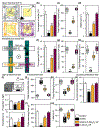Nanotechnology-empowered therapeutics targeting neurodegenerative diseases
- PMID: 37248794
- PMCID: PMC10525015
- DOI: 10.1002/wnan.1907
Nanotechnology-empowered therapeutics targeting neurodegenerative diseases
Abstract
Neurodegenerative diseases are posing pressing health issues due to the high prevalence among aging populations in the 21st century. They are evidenced by the progressive loss of neuronal function, often associated with neuronal necrosis and many related devastating complications. Nevertheless, effective therapeutical strategies to treat neurodegenerative diseases remain a tremendous challenge due to the multisystemic nature and limited drug delivery to the central nervous system. As a result, there is a pressing need to develop effective alternative therapeutics to manage the progression of neurodegenerative diseases. By utilizing the functional reconstructive materials and technologies with specific targeting ability at the nanoscale level, nanotechnology-empowered medicines can transform the therapeutic paradigms of neurodegenerative diseases with minimal systemic side effects. This review outlines the current applications and progresses of the nanotechnology-enabled drug delivery systems to enhance the therapeutic efficacy in treating neurodegenerative diseases. This article is categorized under: Therapeutic Approaches and Drug Discovery > Nanomedicine for Neurological Disease Therapeutic Approaches and Drug Discovery > Emerging Technologies.
Keywords: blood brain barrier; central nervous system; drug delivery; nanotechnology; neurodegenerative diseases.
© 2023 Wiley Periodicals LLC.
Conflict of interest statement
Conflict of Interest
All authors in this review have no competing of interest.
Figures






References
-
- Adhikari A, Mondal S, Das M, Biswas P, Pal U, Darbar S, Bhattacharya SS, Pal D, Saha-Dasgupta T, Das AK, Mallick AK, & Pal SK (2021). Incorporation of a Biocompatible Nanozyme in Cellular Antioxidant Enzyme Cascade Reverses Huntington’s Like Disorder in Preclinical Model. Adv Healthc Mater, 10(7), e2001736. 10.1002/adhm.202001736 - DOI - PubMed
-
- Akinc A, Maier MA, Manoharan M, Fitzgerald K, Jayaraman M, Barros S, Ansell S, Du X, Hope MJ, Madden TD, Mui BL, Semple SC, Tam YK, Ciufolini M, Witzigmann D, Kulkarni JA, van der Meel R, & Cullis PR (2019). The Onpattro story and the clinical translation of nanomedicines containing nucleic acid-based drugs. Nat Nanotechnol, 14(12), 1084–1087. 10.1038/s41565-019-0591-y - DOI - PubMed
Publication types
MeSH terms
Grants and funding
LinkOut - more resources
Full Text Sources
Medical
Research Materials

